
When I was a sophomore in college, I moved into a dormitory that had previously been used as a fraternity house. There were a lot of things that made it different than a typical dorm, but the thing I was most excited about was the large kitchen.
Over the previous year, I started to become interested in cooking, especially food that was healthy. The prospect of having a full kitchen available made me decide to skip the cafeteria meal plan, plan to go grocery shopping on a regular basis, and cook healthy recipes for most of my meals.
Like many plans, I certainly had good intentions, but I didn't implement it very well. By the end of the school year, I was so busy with homework and finals that the majority of my meals ended up being off-brand mac and cheese bowls heated up in the microwave. It was not really healthy, but it was inexpensive, quick, and easy, and I was at least able to eat.
As you build out your church's communication strategy, consider using any or all of the following tools to help you gain a better understanding of your situation, your audiences, and what you are communicating. A detailed communication strategy should include all of these ingredient in some form, but you don't need to wait to get started until you have all of them in place.
SWOT Analysis
A SWOT (Strengths, Weaknesses, Opportunities, and Threats) analysis is a thorough review of your current situation. By asking your church leaders and members basic questions framed around positive and negative characteristics about your congregation and the environment you are in, you can establish an honest evaluation of your church that may be referenced throughout your communication efforts.
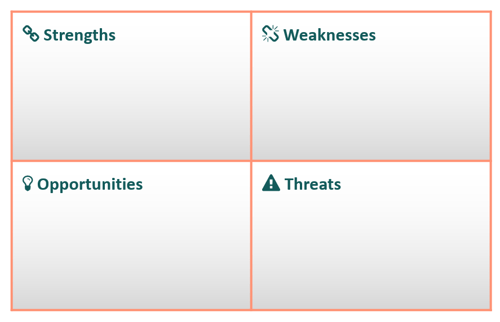
Mission Statement
Your church’s Mission Statement identifies the who, what, and why of your church. I'll often say it is how your church lives out the Great Commission in this time and place. It clarifies your church's identity and establishes the desired baseline of daily operations for your church. This provides a standard or curb for what activities you should pursue and which you should not.
Ministry Goals
Your church's Ministry Goals are specific, desirable results that have not yet been achieved, but are priorities at this time. All goals should branch out from your church's Mission Statement and should follow the SMART criteria, meaning they are Specific, Measurable, Achievable, Relevant, and Timely. Your Ministry Goals will promote accountability because they are clearly and publicly stated, but also energize staff and members towards a desired way of pursuing the church's mission.
Personas
Personas are fictional representations of your target audience. They add personalization to your communication, rather than generalization, and remind you that you are communicating with individuals, not data points. To determine personas, start with your church's Mission Statement; who are you called to reach? Next, move to your Ministry Goals; who is the goal recipient? Personas should be general enough that every adult in your congregation can be easily assigned to a persona, but specific enough to accurately describe how to communicate with those individual members.
Persona Profiles
A Persona Profile is a detailed description of your persona. Profiles for your personas breathe humanity back into your research and help you understand the backgrounds, interests, and pain points of the humans you will be directing messages to. Profiles should be based on real people, but not so much so that they describe individuals in your audience. When your profiles are well defined, it will be easier to shape consistent messages for each audience.
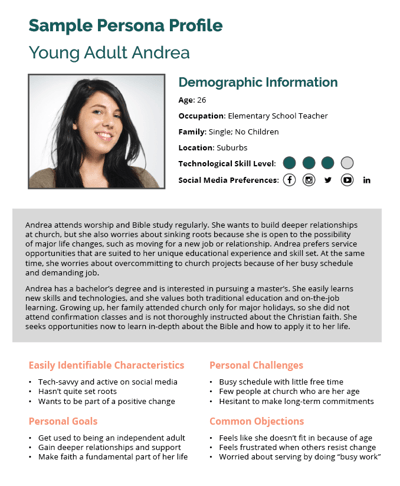
Journey Maps
Journey Maps are the communications equivalent of a sales funnel (without the sales) that helps you visualize where someone is on the path toward your church's goals and direct them to the next step. It helps you send the right message to the right people at the right time. Are you writing an email about an upcoming voter's meeting? Best to remove first-time visitors from the recipient list. Does your blog post talk about what to expect as a first-time visitor? Might not need to email it to longtime members.
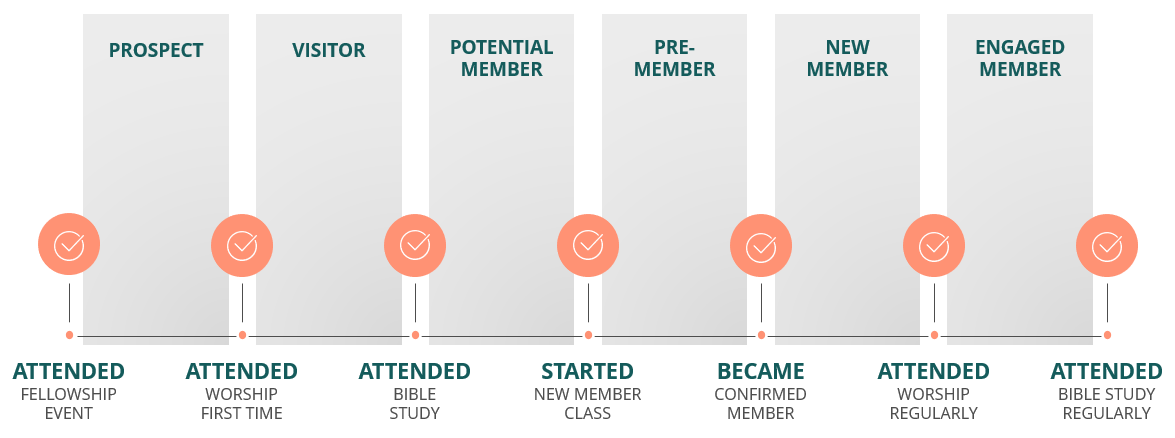
Message Map
A message map is a visual representation of your primary messages that helps you plan out your talking points based on your Mission Statement and each Ministry Goal. This can help jump-start your communications if you don't know what to say to a certain audience, and it keeps your messages consistent. Message Maps also prioritize your communications by always lead back to your central message.
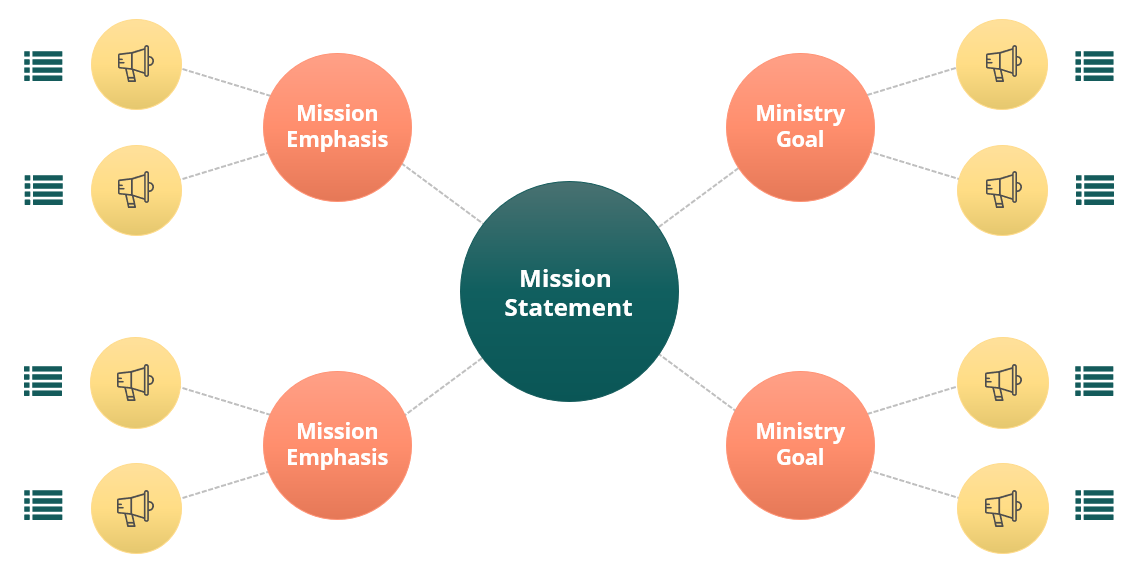
Content Map
A Content Map shows the messages you want to communicate with your personas at different stages of your journey map. In reality, it is simply documenting the things that we do naturally when we speak with other people. The delivery vehicle and wording will vary by persona, but the purpose of the right message delivered to the right audience at the right time is the same.
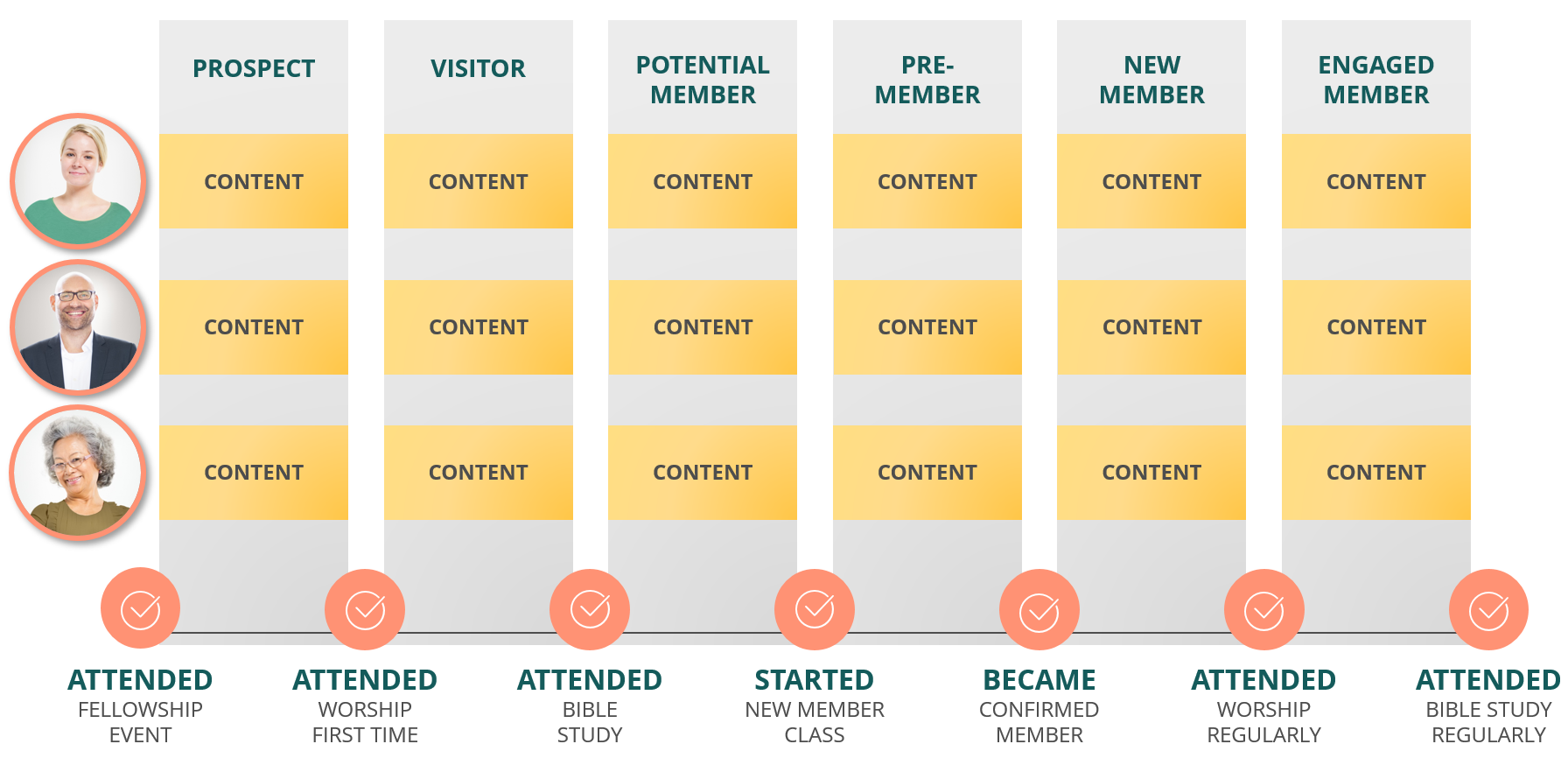
Content Framework
A content framework is an organized manner of distributing your content across all your communication channels, or in simpler terms, a strategy for sharing content. The three elements of a content framework include Home Base (where your audience advances on the journey map), Media Empire (where your audience finds your messages), and outposts (where you can find your audience).
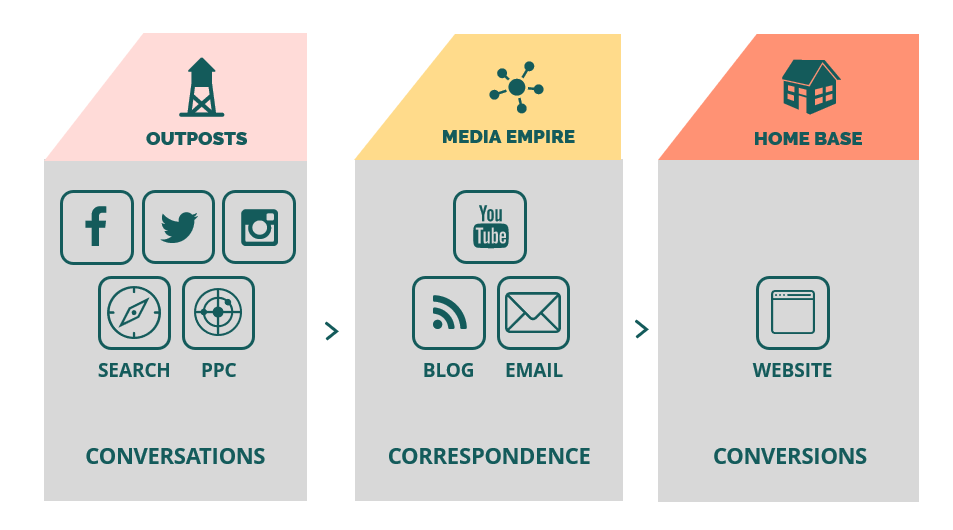
Campaign Templates
Campaign Template are visual representations of a coordinated communications effort, usually shown in the form of a chart. It shows out all the individual communication actions in a single, repeatable format which is designed to be repeatable in order to save you time. It helps you see, for instance, how a social media post points to a blog post, which points to a sign-up form on your church's website.
Download a Free Campaigns Worksheet »
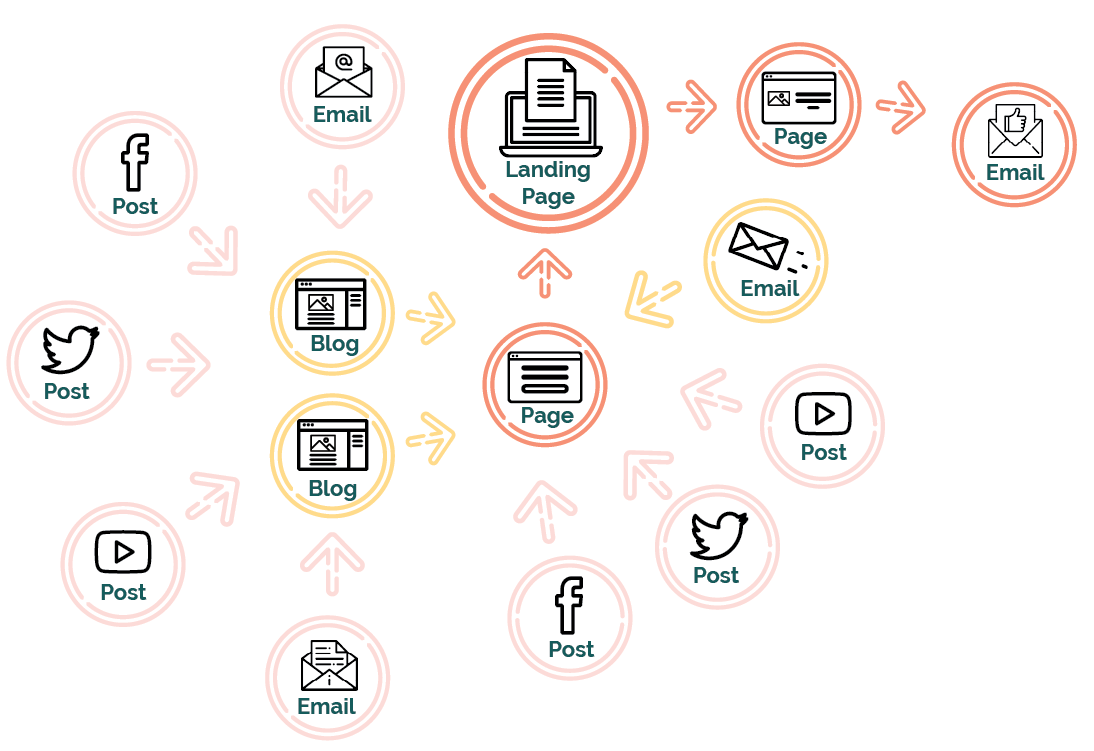
Communication Calendar
To help keep track of all the different communication initiatives going on at your church, the last tool on this list is a Communications Calendar. This detailed scheduled of all your efforts should include "tent poles" such as Christmas and Easter, large one-time campaigns based on Ministry Goals, ongoing efforts that happen regularly (every month, every week, or even every day), and anything else that requires you to communicate with your audience. Having a centralized calendar allows your team to stay organized, even if you are a team of one.
All of these tools and more are taught in the free online Church Communications Strategy Training Course. While the live sessions have ended, the course materials are all available in the Concordia Technology Solutions Resource Center and may be shared with anyone in your congregation.
![]()
About the Author
Follow on Linkedin More Content by Peter Frank



![Campaigns: Scheduling Your Communications [Church Communications Strategy Training Course Session 7]](https://content.cdntwrk.com/mediaproxy?url=https%3A%2F%2Fcdn.slidesharecdn.com%2Fss_thumbnails%2Fchurchcommunicationsstrategytrainingcourse-session7-200610124801-thumbnail.jpg%3Fwidth%3D120%26height%3D120%26fit%3Dbounds&size=1&version=1665679078&sig=522ef1ce9d526a39a54eb1b35d4532e3&default=)


![Ministry Goals: Defining Your Purpose [Church Communications Strategy Training Course Session 1]](https://content.cdntwrk.com/mediaproxy?url=https%3A%2F%2Fcdn.slidesharecdn.com%2Fss_thumbnails%2Fchurchcommunicationsstrategytrainingcourse-session1-200429142121-thumbnail.jpg%3Fwidth%3D120%26height%3D120%26fit%3Dbounds&size=1&version=1665679078&sig=ee681b44eafbd9c389919b845b7a98e9&default=)

![Persona Profiles: Understanding Your Audience [Webinar Recording]](https://content.cdntwrk.com/mediaproxy?url=https%3A%2F%2Fi.ytimg.com%2Fvi%2FbqYfxFu4ddU%2Fhqdefault.jpg&size=1&version=1665679078&sig=26789a625643ab0ffb5bf8896bb4ebab&default=)
![Persona Profiles: Understanding Your Audience [Church Communications Strategy Training Course Session 2]](https://content.cdntwrk.com/mediaproxy?url=https%3A%2F%2Fcdn.slidesharecdn.com%2Fss_thumbnails%2Fchurchcommunicationsstrategytrainingcourse-session2-200506135303-thumbnail.jpg%3Fwidth%3D120%26height%3D120%26fit%3Dbounds&size=1&version=1665679078&sig=2aefea17e68e88ae91e91147ac5c60e3&default=)

![Journey Maps: Planning Your Idea Path [Webinar Recording]](https://content.cdntwrk.com/mediaproxy?url=https%3A%2F%2Fi.ytimg.com%2Fvi%2FdnL2Vd9-mTQ%2Fhqdefault.jpg&size=1&version=1665679078&sig=7b0f7a5d6153249d47c70bfa4104660c&default=)
![Journey Maps: Planning Your Ideal Path [Church Communications Strategy Training Course Session 3]](https://content.cdntwrk.com/mediaproxy?url=https%3A%2F%2Fcdn.slidesharecdn.com%2Fss_thumbnails%2Fchurchcommunicationsstrategytrainingcourse-session3-final-200513120224-thumbnail.jpg%3Fwidth%3D120%26height%3D120%26fit%3Dbounds&size=1&version=1665679078&sig=a2d2d6c1caccb03f4a89b5f96c6e3a42&default=)

![Content Maps: Aligning Your Messages [Webinar Recording]](https://content.cdntwrk.com/mediaproxy?url=https%3A%2F%2Fi.ytimg.com%2Fvi%2FLeNwJEOsxVI%2Fhqdefault.jpg&size=1&version=1665679078&sig=6943b16757fa4b23eebf4ad67dab9ac0&default=)
![Content Maps: Aligning Your Messages [Church Communications Strategy Training Course Session 4]](https://content.cdntwrk.com/mediaproxy?url=https%3A%2F%2Fcdn.slidesharecdn.com%2Fss_thumbnails%2Fchurchcommunicationsstrategytrainingcourse-session4slidedeck-200520124525-thumbnail.jpg%3Fwidth%3D120%26height%3D120%26fit%3Dbounds&size=1&version=1665679078&sig=0a896e797d2cde5f64f2e228a42106e3&default=)

![Social Media: Establishing Your Outposts [Webinar Recording]](https://content.cdntwrk.com/mediaproxy?url=https%3A%2F%2Fi.ytimg.com%2Fvi%2Fjv_SjJkHGZU%2Fhqdefault.jpg&size=1&version=1665679078&sig=bc0e533834c187681a7069f55eba2606&default=)
![Social Media: Establishing Your Outposts [Church Communications Strategy Training Course Session 5]](https://content.cdntwrk.com/mediaproxy?url=https%3A%2F%2Fcdn.slidesharecdn.com%2Fss_thumbnails%2Fchurchcommunicationsstrategytrainingcourse-session5-200527124402-thumbnail.jpg%3Fwidth%3D120%26height%3D120%26fit%3Dbounds&size=1&version=1665679078&sig=1aa62533b0150017ad3dc6066079c4cd&default=)

![Church Websites: Creating Your Home Base [Webinar Recording]](https://content.cdntwrk.com/mediaproxy?url=https%3A%2F%2Fi.ytimg.com%2Fvi%2Fc6PAgywry04%2Fhqdefault.jpg&size=1&version=1665679078&sig=ba916a8b0cbc0ebd51bd025d01c937b2&default=)
![Church Websites: Creating Your Home Base [Church Communications Strategy Training Course Session 6]](https://content.cdntwrk.com/mediaproxy?url=https%3A%2F%2Fcdn.slidesharecdn.com%2Fss_thumbnails%2Fchurchcommunicationsstrategytrainingcourse-session6-200603143909-thumbnail.jpg%3Fwidth%3D120%26height%3D120%26fit%3Dbounds&size=1&version=1665679078&sig=798cda1cf6eb8928317adced94edf80e&default=)

![Campaigns: Scheduling Your Communications [Webinar Recording]](https://content.cdntwrk.com/mediaproxy?url=https%3A%2F%2Fi.ytimg.com%2Fvi%2FcckdAByd4wA%2Fhqdefault.jpg&size=1&version=1665679078&sig=6d9f02b762058e4ab2f0e1642363b49f&default=)